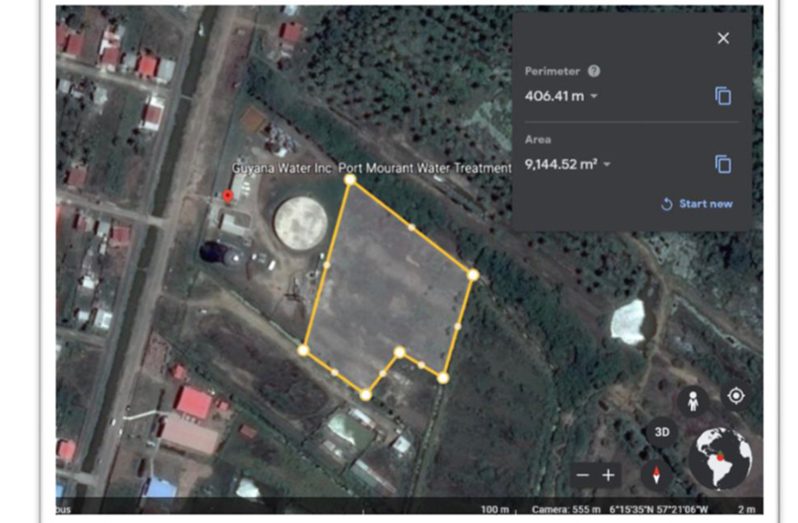IN an effort to reduce its carbon footprint and high electricity costs, the Guyana Water Incorporated (GWI) is planning to construct a solar farm at its Port Mourant Water Treatment Plant.
The utility company applied for an environmental authorisation for the project last year.
In a detailed application to the Environmental Protection Agency (EPA), GWI laid out its case for improving the carbon footprint of water supply
through the use of the sun as a renewable energy source.
According to GWI, the Port Mourant Water Treatment Plant which was established in 2000, has an estimated annual energy output from a 400
kWp solar PV system of 590MWh. This is equivalent to approximately 1,490 PV panels requiring approximately 9,200m2 of space.
The total capital investment for the existing and proposed projects is just over $1.7 billion.
The company explained that given the required landmass, no feasible and reasonable alternative is currently available to GWI and in the event that the proposed location cannot be used, approval will have to be sought from the Government of Guyana for land.
It added that no pollutants will be generated from the solar farm during its construction and design life. At the end of the design life of the panels, GWI said it will prioritise the recycling and reclamation of any recyclable components, after which, it will dispose of the remaining components in accordance with the EPA guidelines.
Approximately 17 per cent of a panel by weight can be recycled. This comprises the aluminum frame of the solar panel and junction box that will be sold to licensed scrap-metal dealers in Guyana. The remaining 83 per cent of materials of a solar panel (including glass, silicon and polymer back sheeting) will be disposed of, GWI said, adding, that this portion also includes hazardous materials which will be disposed of in accordance with the Hazardous Waste Management Regulations of the EPA.
According to the 15-page document which was seen by this publication, the company’s annual energy consumption is 1.27 million KWh of fossil fuels. The proposed project would allow for the utilisation of 0.59 million KWh of energy which will be generated from the sun.
“The proposed project will require an isolated/strip footing or pile foundation to be used to mount the panel modules, thereby minimising the surface coverage at the site upon completion. Landscape drainage is included in the scope of works to mitigate against [sic] flooding at the site,” GWI said, adding that no other major infrastructural works would be required.
The company noted that the proposed project was designed to negatively impact the environment or the water-treatment plant.
In summing up its case, GWI explained that over the years, the company’s energy consumption has been very high.
“Present yearly energy consumption across GWI facilities is 46.6 million kWh. Electricity accounts for more than 60 per cent of GWI’s operating costs. In 2020, GWI spent more than US$13.7 million on electricity, and GWI’s electricity consumption was over five per cent of the total electricity generated by the
country’s electric utility (GPL),” GWI disclosed in its application.
It added that to reduce energy costs from ever-increasing electricity tariffs is
of paramount importance for the improvement of the quality of service being provided to Guyanese, as well as for the achievement of GWI’s economic sustainability.
“Guyana’s government emphasises increasing the role of renewable energy in the energy mix in the country to meet the energy demands sustainably. Renewable energy plays a critical role in reducing dependence on imported fossil fuels, while at the same time reducing oil-import bills and increasing energy security. Water- treatment plants are ideal end-users for integrating solar PV power plants under a grid-tie net metering scheme. Port Mourant is a water-treatment plant that is energy-intensive, where grid-tie-based solar PV system integration is a potential
option,” the company added.
Further, it was noted that as a part of the low-carbon development strategy (LCDS), solar PV power projects are encouraged by the Government of Guyana.
GWI said that the proposed system can generate a maximum peak power of 320 kWp range. The estimated annual energy output from 400 kWp solar PV system is 0.59 million kWh.
“The solar PV power generation share can substitute close to 45 per cent of the present energy-consumption level. The reduction in [the] energy bill after integration of solar PV power plant could be above 40 per cent,” GWI said.
It was also explained that aside from the reduction in the monthly electricity expenditure for the company, the proposed project can also lead to other social and economic benefits, such as job creation.



.jpg)








